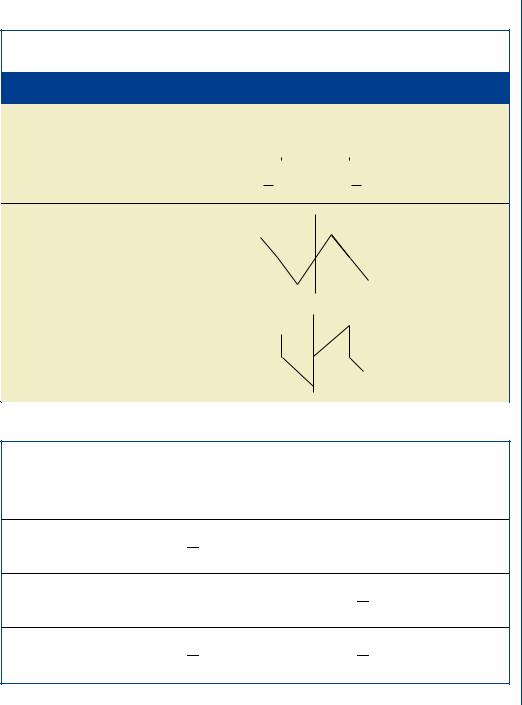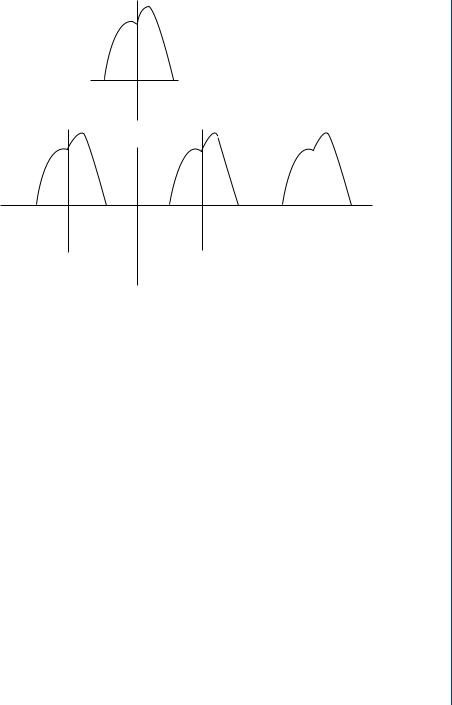
Signal Processing of Random Physiological Signals - Charles S. Lessard
.pdf
FOURIER SERIES: TRIGONOMETRIC 131
TABLE 12.10 SUMMARY OF SYMMETRY TABLES
TABLE A: Waveform Symmetry
SYMMETRY CONDITION |
ILLUSTRATION PROPERTY |
Even |
f (t) |
= |
f ( |
− |
t) |
– 2 |
f |
|
|
2 |
|
|||||
|
|
|||||||||||||||
|
|
|
|
|||||||||||||
|
|
|
|
|||||||||||||
|
|
|
|
T |
|
|
|
|
T |
t |
||||||
|
|
|
|
|
|
|
|
|
|
|
|
|
|
|
|
|
|
|
|
|
|
|
|
|
|
|
|
|
|
|
|
|
|
cosine terms only
f
Odd |
f (t) |
= − |
f ( |
− |
t) |
– 2 |
|
2 |
|
|
|
sine terms only |
||||||
|
|
|
|
T |
|
|
|
T |
t |
|
||||||||
|
|
|
|
|
|
|
|
|
|
|
|
|
|
|
|
|
|
|
|
|
|
|
|
|
|
|
|
|
|
|
|
|
|
|
|
|
|
|
|
|
|
|
|
|
|
|
|
|
f |
|
|
|
|
|||
Half-wave |
f (t) = − f (t ± T/2) |
|
|
|
|
|
|
|
|
|
|
t |
odd n only |
|||||
|
|
|
– |
|
T |
|
T |
|
|
|
||||||||
|
|
|
|
|
|
|
|
|
|
|
|
|
|
|
||||
|
|
|
|
|
|
|
|
|
2 |
2 |
|
|
|
|
|
|||
|
|
|
|
|
|
|
|
|
|
|
|
|
|
|
||||
TABLE B: Fourier Transform of Symmetrical Waveforms
PROPERTY |
a0 |
an (n = 0) |
|
bn |
|
|
|
|
|
|
|
|
4 |
T/2 |
|
|
|
cosine terms only |
f (t) cos nω0t dt |
|
0 |
||
* |
|
||||
|
T |
0 |
|
|
|
|
|
|
4 |
T/2 |
|
sine terms only |
0 |
0 |
f (t) sin nω0t dt |
||
T |
|||||
|
|
|
0 |
||
|
4 |
T/2 |
4 |
T/2 |
|
Odd n only |
f (t) cos nω0t dt |
f (t) sin nω0t dt |
|||
0 |
T |
||||
|
T |
0 |
0 |
||
|
|
|
|
|

132 SIGNAL PROCESSING OF RANDOM PHYSIOLOGICAL SIGNALS
|
|
|
|
|
+V |
|
Volts |
|
|
|
|||
|
|
|
|
|
|
|
|
T/4 |
|
3T/4 t |
|||
|
|
|
|
|
|
|
0 |
|
|||||
|
|
|
–T/2 |
|
|
T/2 |
|
|
|
||||
|
|
|
|
|
|
|
|
|
|
|
|
|
|
|
|
–T |
|
|
|
|
T |
||||||
|
|
|
|
|
|
|
|
|
|
|
|
|
|
FIGURE 12.6: Square waveform for example problem
By inspection, the average value over one period is zero so that a0 = 0. Value of a1 with n = 1 is
|
2 |
|
|
T/4 |
|
|
|
|
|
3/4 T |
|
|
|
|
|
T |
|
|
|
|
|
|
an = T |
V |
0 |
cos nω0t d t − V |
T/ |
|
cos nω0t d t + V |
3/ T cos nω0t d t |
|
|
|||||||||||||
|
|
|
|
|
|
|
|
|
|
4 |
|
|
|
|
|
|
4 |
|
|
|
|
|
an = |
2V |
|
|
1 |
sin nω0t |
T/4 |
1 |
sin nω0t |
|
3/4 T |
|
1 |
sin nω0t |
T |
|
|||||||
T |
|
nω0 |
− |
nω0 |
|
T |
+ |
nω0 |
3 |
T |
||||||||||||
|
|
|
|
|
|
|
|
|
0 |
|
|
|
|
|
/4 |
|
|
|
|
|
/4 |
|
an = |
2V |
|
|
ω0T |
|
|
|
3ω0T |
|
ω0T |
|
|
sin ω0T − sin |
3ω0T |
|
|
||||||
ω0T |
|
sin |
4 |
|
− |
sin |
4 |
− sin |
4 |
|
+ |
4 |
|
|
||||||||
Since ω0T = 2Tπ · T = 2π , then |
|
|
|
|
|
|
|
|
|
|
|
|
|
|||||||||
for n = 1, a1 = |
2V |
|
π |
|
|
3π |
|
π |
|
|
sin 2π − sin |
3π |
|
|
|
|||||||
2π sin |
2 |
− |
sin |
2 |
− sin 2 |
+ |
2 |
|
|
|
||||||||||||
|
|
a1 = |
V |
[1 − (−1 − 1) + (0 − (−1))] = |
V |
[1 |
+ 2 + 1] |
= |
4V |
|
|
|||||||||||
|
|
π |
π |
π |
|
|
||||||||||||||||
|
|
|
|
2 |
|
|
T/4 |
|
|
|
3/4 T |
|
|
|
|
|
T |
|
|
|
||
|
|
an = |
T |
V |
0 |
|
cos nω0t dt − V T/4 |
cos nω0t dt + V |
3/4 T cos nω0t dt |
|||||||||||||
|
|
an = |
2V 1 |
|
sin nω0t |
T/4 |
|
1 |
sin nω0t |
3/4 T |
1 |
sin nω0t |
T |
|||||||||
|
|
T |
nω0 |
0 |
− |
nω0 |
T |
+ |
nω0 |
3 |
||||||||||||
|
|
|
|
|
|
|
|
|
|
|
|
|
|
|
/4 |
|
|
|
|
/4T |
||

|
|
|
|
|
|
|
|
|
|
|
|
|
|
|
|
|
|
|
|
|
|
|
|
FOURIER SERIES: TRIGONOMETRIC 133 |
||||||||||||||||
Since 2ω0T = 4π , then: |
|
|
|
|
|
|
|
|
3T |
|
|
|
|
|
|
|
|
|
|
|
|
3T |
||||||||||||||||||
|
|
|
|
|
|
2V |
|
|
|
|
T |
|
|
|
|
|
|
|
|
|
|
|
T |
|
|
|
|
|
|
|||||||||||
For n = 2, a2 = |
|
|
|
|
sin 2ω0 |
|
− sin 2ω0 |
|
|
|
− sin 2ω0 |
|
|
sin 2ω0T − sin 2ω0 |
|
|
||||||||||||||||||||||||
2ω0T |
4 |
|
4 |
4 |
4 |
|||||||||||||||||||||||||||||||||||
|
2V |
|
|
|
4π |
|
|
4π · 3 |
|
|
|
|
π |
|
|
|
|
π |
|
|
|
|
π |
|
|
|
|
|
|
|
||||||||||
a2 = |
4π |
|
sin |
|
|
|
|
|
|
|
− sin |
|
+ (sin 4 |
− sin 3 |
) |
|
|
|
|
|
|
|||||||||||||||||||
4 − sin |
4 |
|
|
|
|
|
|
|
|
|
|
|
|
|
|
|
||||||||||||||||||||||||
a2 = |
2V |
|
|
[0 − (0 − 0) + (0 − 0)] = 0 |
|
|
|
|
|
|
|
|
|
|
|
|
|
|
|
|
|
|
|
|
|
|||||||||||||||
|
|
|
|
|
|
|
|
|
|
|
|
|
|
|
|
|
|
|
|
|
|
|
||||||||||||||||||
4π |
|
|
|
|
|
|
|
|
|
|
|
|
|
|
|
|
|
|
|
|
|
|||||||||||||||||||
Likewise, an = 0 for all even values of an . |
|
|
|
|
|
|
|
|
|
|
|
|
|
|
|
|
|
|
|
|
|
|||||||||||||||||||
Since ω0T = 2π, then nω0T for n = 3 is 3ω0T = 6π. |
|
|
|
|
|
|
|
|
|
|||||||||||||||||||||||||||||||
|
|
, |
|
|
|
|
2V |
6π |
|
|
|
|
|
6π · 3 |
|
|
6π |
|
|
|
|
|
|
π |
|
6π · 3 |
|
|||||||||||||
|
|
|
|
|
|
|
|
|
|
|
|
|
|
|
|
|
|
|
|
|
|
|
|
|
|
|
|
|
||||||||||||
For n = 3 |
a3 = |
|
6π |
sin 4 |
− |
|
|
− sin |
4 |
|
+ |
sin 6 |
− sin |
4 |
||||||||||||||||||||||||||
|
|
|
|
sin |
4 |
|
|
|
|
|
|
|
||||||||||||||||||||||||||||
|
|
|
|
a3 = |
|
V |
[−1 − (+1 − (−1)) + 0 − (+1)] |
|
|
|
|
|
|
|
|
|
|
|
|
|||||||||||||||||||||
|
|
|
|
|
|
|
|
|
|
|
|
|
|
|
|
|
|
|||||||||||||||||||||||
|
|
|
|
|
3π |
|
|
|
|
|
|
|
|
|
|
|
|
|||||||||||||||||||||||
|
|
|
|
a3 = |
|
V |
[−1 − 2 − 1] = − |
4V |
|
|
|
|
|
|
|
|
|
|
|
|
|
|
|
|
|
|
||||||||||||||
|
|
|
|
|
|
|
|
|
|
|
|
|
|
|
|
|
|
|
|
|
|
|
|
|
|
|||||||||||||||
|
|
|
|
|
3π |
|
3π |
|
|
|
|
|
|
|
|
|
|
|
|
|
|
|
|
|
|
|||||||||||||||
Applying the same procedure for all n, we find that |
|
|
|
|
|
|
|
|
|
|
|
|
|
|
|
|||||||||||||||||||||||||
|
|
|
|
|
|
|
|
|
|
|
|
|
|
|
+ |
4V |
|
n = 1, 5, 9, . . . |
|
|
|
|
|
|
|
|
|
|||||||||||||
|
|
|
|
|
|
|
|
|
|
|
|
|
|
|
|
, |
|
|
|
|
|
|
|
|
|
|
||||||||||||||
|
|
|
|
|
|
|
|
|
|
|
|
|
|
|
nπ |
|
|
|
|
|
|
|
|
|
|
|||||||||||||||
|
|
|
|
|
|
|
|
|
|
an = |
|
− |
4V |
|
n = 3, 7, 11, . . . |
|
|
|
|
|
|
|
|
|
||||||||||||||||
|
|
|
|
|
|
|
|
|
|
|
|
, |
|
|
|
|
|
|
|
|
|
|
||||||||||||||||||
|
|
|
|
|
|
|
|
|
|
|
nπ |
|
|
|
|
|
|
|
|
|
|
|||||||||||||||||||
|
|
|
|
|
|
|
|
|
|
|
|
|
|
|
|
0, |
|
|
|
n = even |
|
|
|
|
|
|
|
|
|
|
|
|
|
|
|
|||||
The imaginary term bn values are calculated as follows:
2
bn = T V
2V bn = nω0T
|
T/4 |
|
|
3/4 T |
|
|
T |
|
0 |
sin nω0t d t − V |
T/ |
sin nω0t d t + V 3/ T sin nω0t d t |
|||||
|
|
|
|
4 |
|
|
4 |
|
(− cos nω0t) |
T/4 |
− (− cos nω0t) |
3/4 T |
+ (− cos nω0t) |
T |
|||
0 |
T/4 |
3/4 T |
||||||
b1 |
= |
2V |
− cos |
|
2π |
|
+ cos 0 − − cos |
6π |
+ cos |
2π |
+ − cos 2π + cos |
6π |
||
nω0T |
4 |
|
4 |
4 |
4 |
|||||||||
b1 = |
2V |
[0 + 1 |
+ 0 |
− 0 − 1 + 0] = 0 |
|
|
|
|
|
|||||
|
|
|
|
|
|
|
||||||||
nω0T |
|
|
|
|
|
|||||||||
|
|
2V |
|
|
|
|
|
|
|
|
|
|
||
b1 |
= |
|
|
(0) = 0 |
|
|
|
|
|
|
|
|
|
|
|
2π |
|
|
|
|
|
|
|
|
|
||||

134 SIGNAL PROCESSING OF RANDOM PHYSIOLOGICAL SIGNALS
If you continue this process for other integers of n, you will obtain bn = 0 for all values of n.
Before moving into Discrete and Fast Fourier transformations and frequencydomain analysis, let me regress into perhaps the most important function to engineers, physicists, and mathematicians—the exponential function—which has the property
that the derivative and integral yield a function proportional to itself as in (12.10).
|
d |
1 |
|
|
||
|
|
e st = sest and |
e st dt = |
|
e st |
(12.10) |
dt |
s |
|||||
It turns out that every function or waveform encountered in practice can always be expressed as a sum of various exponential functions.
12.5 EULER EXPANSION
Euler showed that the expression, s = − j ω, of a complex frequency represents signals oscillating at angular frequency, ω, and that the cos ωt could thereby then be represented as (12.11).
e j ωt + e − j ωt
(12.11)
2
In a way, the Discrete Fourier Series is a method of representing periodic sig-
nals by exponentials whose frequencies lie along the j ω axis. Expressing the Fourier Trigonometric Series in an equivalent form in terms of exponentials, or e ± j nωt :
|
|
|
∞ |
(an cos nω0t + bn sin nω0t) |
|
|
|||||||||
f (t) = a0 + |
|
|
|||||||||||||
|
1 |
|
n=1 |
|
|
|
|
|
|
|
|
|
|
|
|
cos nω0t = |
|
e j nω0t + e − j nω0t |
|
|
|
|
|
|
|
|
|||||
|
|
|
|
|
|
|
|
|
|
||||||
2 |
|
|
|
|
|
|
|
|
|
||||||
sin nω0t = |
1 |
e j nω0t − e − j nω0t |
|
|
|
|
|
|
|
|
|||||
2 j |
|
|
|
|
e j nω0t − e − j nω0t |
||||||||||
|
|
|
∞ |
|
|
e j nω0t + e − j nω0t |
|
||||||||
then f (t) = a0 + |
|
an |
|
|
2 |
|
|
+ bn |
|
2 j |
|
||||
|
|
|
n=1 |
|
|
|
|
|
|
|
|
|
|
|
|
Grouping terms, − j = 1j : |
|
|
|
|
|
|
|
|
|
|
|
|
|||
f (t) = a0 + |
∞ |
|
an − j bn |
|
e |
j nω0t |
+ |
|
an + j bn |
e |
− j nω0t |
||||
|
2 |
|
|
2 |
|
||||||||||
|
|
n=1 |
|
|
|
|
|
|
|
|
|
|
|
|
|

FOURIER SERIES: TRIGONOMETRIC 135
Redefining coefficients:
˜ |
an − j bn |
, |
˜ |
an + j bn |
, |
˜ |
= a0 |
|
2 |
2 |
|||||||
c n = |
|
c −n = |
|
and c 0 |
Then, the Fourier expression for a function may be written as (12.12):
˜ |
|
∞ |
j nω0t |
˜ |
− j nω0t |
|
+ |
˜ |
(12.12) |
||||
f (t) = c 0 |
c n e |
|
+ c −n e |
|
n=1
Letting n range from 1 to ∞ is equivalent to letting n range from −∞ to +∞, including 0.
|
|
|
Then f (t) = |
∞ |
|
˜ |
j nω0t |
|
|
|
|
||||||
|
|
|
|
|
|
|
|
|
|||||||||
|
|
|
|
|
cn e |
|
|
|
|
|
|
||||||
|
|
|
|
|
|
|
|
n=−∞ |
|
|
|
|
|
|
|
||
˜ |
|
|
|
|
|
|
|
|
|
|
|
|
|
|
|
|
|
The coefficients c n can be evaluated in terms of an and bn as shown in (12.13). |
|
||||||||||||||||
˜ |
1 |
|
|
|
|
|
1 |
|
|
|
|
|
−1 |
bn |
|
|
|
2 |
|
2 |
|
and |
φ |
n = tan |
(12.13) |
||||||||||
|
|
|
|
|
|||||||||||||
2 |
|
2 c n |
|
||||||||||||||
|c n | = |
an |
+ bn = |
|
an |
|||||||||||||
|
|
|
|
|
˜ |
|
˜ |
| e |
j θ n |
|
|
|
|
|
|
||
|
|
|
|
|
c n = |c n |
|
− j θ n |
|
|
|
|
|
|||||
|
|
|
|
˜ |
|
˜ |
|
|
˜ |
e |
|
|
|
|
|
||
|
|
|
|
c n |
= c n |
= |c n | |
|
|
|
|
|
|
|
||||
Note that in (12.13), the coefficients of the exponential Fourier Series are 1/2 the magnitude of the geometric Fourier Series coefficients.
12.6 LIMITATIONS
Overall, the Fourier Series method has several limitations in analyzing linear systems for the following reasons:
1.The Fourier Series can be used only for inputs that are periodic. Most inputs in practice are nonperiodic.
2.The method applies only to systems that are stable (systems whose natural response decays in time).
The first limitation can be overcome if we can represent the nonperiodic input, f (t), in terms of exponential components, which can be done by either the Laplace or

136 SIGNAL PROCESSING OF RANDOM PHYSIOLOGICAL SIGNALS
Fourier Transform representation of f (t). Consider the following nonperiodic signal, f (t), which one would like to represent by eternal exponential functions. As a result, we can construct a new periodic function, fT (t), with period T, where the function f (t) is represented every T seconds. The period, T, must be large enough so there is not any overlap between pulse shapes of f (t). The new function is a periodic function and can be represented with an exponential Fourier Series.
12.7 LIMITING PROCESS
What happens if the interval, T, becomes infinite for a pulse function, f (t)? Do the pulses repeat after an infinite interval? Such that fT (t) and f (t) are identical in the limit, and the Fourier Series representing the periodic function, fT (t), will also represent f (t)?
Discussion on Limiting Process: Let the interval between pulses become infinite, T =
∞, in the series, so we can represent the exponential Fourier Series for |
fT (t) as in |
(12.14). |
|
∞ |
|
Fn e j nω0t |
(12.14) |
n=−∞ |
|
Where ω0 is the fundamental frequency and Fn is the term which represents the amplitude of the component of frequency, nω0, the coefficient. As T becomes larger, the fundamental frequency, ω0, becomes smaller, and the amplitude of individual components also become smaller as shown in (12.15). The frequency spectrum becomes denser, but its shape is unaltered.
Limit T → ∞, ω0 → 0 |
(12.15) |
The spectrum exists for every value of ω and is no longer discrete but a continuous function of ω. So, let us denote the fundamental frequency ω0 as being infinite. The logic is as follows:
Since Limit T → ∞, ωo → 0, then T = 2π ,
ω
and TFn is a function of j n ω, or T F = F ( j n ω).

FOURIER SERIES: TRIGONOMETRIC 137
f (t)
Nonperiodic
t
0
Periodic
fT (t)
0
FIGURE 12.7: A transient pulse. Top trace is a transient; bottom trace is periodic
It is an accepted fact that a periodic function, fT (t), can be expressed as the sum of eternal exponentials of frequencies 0, ± j ω, ± j 2 ω, ±3 j ω . . . etc. Also, it is known that the Fourier Transform, Fn , amplitude of the component of frequency, jn ω, is expressed as F ( j n ω) ω 2π .
Proof of the Limiting Process: Viewing Fig. 12.7, let us examine the proof of the limiting process.
Let us begin with the general expression (12.16):
In the Limit as T → ∞ : |
Lim |
( |
) |
( |
) |
(12.16) |
|
T |
→∞ |
fT t |
|
= f t |
|
|
|
|
|
|
|
|
|
|
|
Then the exponential Fourier Series for fT (t) is given by (12.17).
fT (t) = |
∞ |
|
Fn e j nω0t |
(12.17) |
n=−∞
where ω |
|
= |
2π and F |
1 |
T/2 |
f |
|
(t) e − j nω0t d t |
|
|
|
|
|||||||
|
0 |
T |
n = |
T −T/2 |
|
T |
|
||

138 SIGNAL PROCESSING OF RANDOM PHYSIOLOGICAL SIGNALS
Since Limit T → ∞, ω0 → 0, ω0 can be denoted by ω (see (12.18))
Then |
2π |
|
2π |
1 |
T/2 |
fT (t) e − j nω0t d t |
(12.18) |
||||||||
T = |
|
|
= |
|
and T Fn = |
|
|
|
|||||||
ω |
0 |
ω |
T |
T |
|||||||||||
|
|
|
|
|
|
− /2 |
|
|
|
|
|
|
|||
Since T Fn ( j n ω), the expression may be rewritten as T Fn = F ( j n ω). |
|
||||||||||||||
|
|
|
|
|
|
∞ |
Fn e j nω0t , becomes (12.19). |
|
|||||||
|
Then (12.17), fT (t) = |
|
|||||||||||||
|
|
|
|
|
|
n=−∞ |
|
|
|
|
|
|
|
|
|
|
|
|
|
|
|
∞ |
F ( j n ω) |
e ( j nω0t)t |
|
||||||
|
|
|
|
|
fT (t) = |
|
|
|
|
|
|
||||
|
|
|
|
|
|
|
T |
|
|
|
|||||
|
|
|
|
|
|
n=−∞ |
|
|
|
|
|
|
|
|
|
|
|
|
|
|
|
∞ |
|
F ( j n ω) |
e ( j nω0t)t |
|
|||||
|
|
|
|
|
fT (t) = |
|
|
|
|
|
|
ω |
(12.19) |
||
|
|
|
|
|
|
|
2π |
|
|
|
|||||
|
|
|
|
|
|
n=−∞ |
|
|
|
|
|
|
|
|
|
Rewriting (12.19) in the “Limit”: as T → ∞, ω0 → 0, fT (t) → f (t), the equation takes the form of (12.20), thus proving the limit process.
f t |
|
= T→∞ fT (t) = |
ω→0 |
2π |
F ( j n |
|
)e |
|
|
( |
) |
Lim |
Lim |
1 |
|
ω |
|
j n ωt ω |
(12.20) |
|
|
|
12.8 INVERSE FOURIER TRANSFORM
To return to the “Time Domain” after transforming into the “Frequency Domain,” the inverse Fourier transform must be obtained. By definition, the Inverse Fourier Transform is written as (12.21). The process is the same as taking the forward transform, except that in lieu of multiplying the time domain function, f (t), by the Fourier Basis Function, all the Fourier Coefficients form the Frequency domain function, Fn = F ( j n ω) ω 2π , are multiplied by the inverse Fourier basis function as in (12.19). Particular emphasis is made to point out that the sign of the basis function exponential frequency, j ωt, is positive for the inverse transformation.
|
|
|
|
|
1 |
|
∞ |
|
|
|
|
|
|
|
|
|
|
|
f |
(t) = |
|
|
F ( j ω) e j ωt d ω |
|
|
|
(12.21) |
||||
|
|
|
2π |
|
|
|
|
||||||||
|
|
|
|
|
|
−∞ |
|
|
|
|
|
|
|
|
|
where |
n |
ω becomes ω |
(a |
continuous |
variable) |
and the |
function |
F ( j |
ω |
) = |
Lim |
||||
|
|
|
|
|
|
|
|
ω |
→ |
0 |
|||||
|
|
|
|
|
|
|
|
|
|
|
|
|
|
|
|
F ( j n ω).

FOURIER SERIES: TRIGONOMETRIC 139
12.9 SUMMARY
The “Forward Fourier Transform” equations are summarized in (12.22) and (12.23).
|
|
|
|
1 |
|
T/2 |
|
− j nω0t d t = |
|
F ( j n ω) |
|
|
|
|||||
|
|
|
Fn = |
|
|
|
T fT (t) e |
|
|
|
|
|
|
|
(12.22) |
|||
|
|
|
T |
|
|
|
|
T |
|
|
||||||||
|
|
|
|
|
− /2 |
|
|
|
|
|
|
|
|
|||||
then |
|
|
T/2 |
f |
|
|
(t) e − j n ωt dt frequency spectrum of f |
|
(t) |
|
||||||||
|
ω |
Li m |
|
|
|
|
||||||||||||
|
F ( j |
|
) = T→∞ −T/2 |
|
T |
|
|
|
|
|
|
|
|
|
T |
|
|
|
|
|
|
or for the infinite case: F ( j ω) = |
∞ |
f (t) e − j ωt |
d t |
(12.23) |
|||||||||||
|
|
|
|
|
|
|||||||||||||
|
|
|
|
|
|
|
|
|
|
−∞ |
|
|
|
|
|
|||
where in the Limit as T → ∞, ω → 0, fT (t) → f (t). |
|
|
|
|||||||||||||||
|
The Discrete Inverse Fourier Transform Lim |
1 |
|
F ( j ω) e j ωt ω is, by defi- |
||||||||||||||
|
2π |
|||||||||||||||||
|
|
|
|
|
|
|
|
|
|
ω→0 |
|
|
|
|
|
|||
|
|
|
|
|
|
|
|
|
|
|
|
|
|
|
|
|
|
|
nition, the integral, which may be expressed as (12.24). |
|
|
|
|
|
|||||||||||||
|
|
|
|
|
|
|
1 |
|
∞ |
|
|
|
|
|
|
|
|
|
|
|
|
|
|
|
f (t) = |
|
|
F ( j ω) e j ωt d ω |
|
|
(12.24) |
||||||
|
|
|
|
|
|
2π |
|
|
|
|||||||||
|
|
|
|
|
|
|
|
|
−∞ |
|
|
|
|
|
|
|
|
|
where n ω becomes a continuous variable, ω, and the function F ( j ω) is F ( j n ω).
The result is that F ( j ω) = |
∞ |
j ωt |
d t is the presentation of the nonperi- |
−∞ f (t) e − |
|
odic function, f (t), in terms of exponential functions. The amplitude of the component of any frequency, ω, is proportional to F ( j ω). Therefore, F ( j ω), represents the frequency spectrum of f (t) and is called the Frequency Spectral of a Function. Equations (12.23) and (12.24) are referred to as the Fourier Transform pair. Equation (12.23) is the
Direct Fourier Transform of f (t), and (12.24) is the Inverse Fourier Transform.
